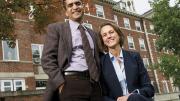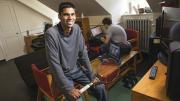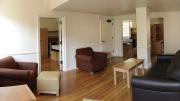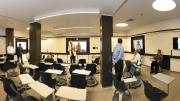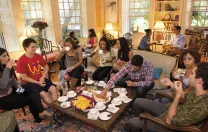In 2008, when Suzy Nelson, then Harvard College’s associate dean for residential life, approached Richard Wrangham and Elizabeth Ross about becoming master and co-master of Currier House, she suggested that it was good to eat with students a few times a week. “Elizabeth wrinkled her nose,” recalls Wrangham, Moore professor of biological anthropology—not at the students’ company, but at memories of institutional food. Nonetheless, they took the job and, on returning in September from Uganda, moved hurriedly into Currier without unpacking their cooking gear, and so immediately ate in the house dining hall with their new charges. After that, “it was sometime in late November,” Ross recalls, “when we ate our first meal not with students.” The Dining Services food was fine, and “it’s just fun being with students, getting to know them,” she says. The couple had raised three sons to adulthood in suburban Weston, in a house they’ve now sold. “We had an empty nest,” says Wrangham. “We filled it with 370 Currier students.”
This kind of informal contact between masters and house residents, senior faculty and undergraduates, may seem unexceptional to College alumni, but it’s rare in American higher education. The only true counterpart to Harvard’s house system as a way to lodge, feed, and educate upperclassmen is an analogous arrangement at Yale (where the units are called “colleges”). At many universities, undergraduates do not even live in dormitories. After freshman year, “at elite state universities, off-campus living is the norm,” says Stephen Lassonde, who arrived at Harvard as dean of student life this year after six years at Brown University and 14 at Yale. Well over 90 percent of University of Michigan upperclassmen, for example, live off campus.
Even within the Ivy League, Harvard and Yale are atypical. “For an urban university to have 97 to 98 percent of its undergraduates living on campus [as at Harvard] is unheard of,” says dean of freshmen Thomas Dingman. (At the University of Pennsylvania, about 51 percent of undergraduates live off campus.) “Of course, the high rents in Cambridge help keep those numbers up,” Dingman adds, “but students perceive that the game in town is in the houses.” Lassonde observes that at the great majority of universities, Brown included, even when dorms are available, “It’s a migratory community—students live in a different building each year. There’s clear age segregation: outside the classroom, the students don’t encounter faculty or other adults. So their sense of what the world is like is very constrained by their peer culture. In my opinion, [the house system] is a much healthier way to live, grow, and develop.”
“The issue of sustaining an intergenerational learning community is really vital,” says Wertham professor Diana Eck, master since 1998 of Lowell House, sharing duties with co-master Dorothy Austin, lecturer on psychology. “Of course, at every college there are residences—fraternities, sororities, dorms. When they move into a house at Harvard, one of the first things sophomores discover is that it’s not a dorm. Yes, it is a place to live, but it’s much more than that. It’s a place where they are in face-to-face contact with each other when they straggle in to breakfast and read the newspaper together, where they come back for lunch and find the place buzzing, where they bring their teaching fellow or a friend over for dinner. It becomes the most important site for their education.”
The University clearly agrees, and has launched a $1-billion-plus, multiyear plan to renovate the 12 undergraduate houses—an enormous, complex project that will figure prominently in the newly launched capital campaign. Last year, renovations began in the older part of Quincy House; this September, students moved back into the building, now renamed Stone Hall after the Harvard Corporation’s late senior fellow, Robert G. Stone Jr. ’45, LL.D. ’03. Work on Leverett House’s McKinlock Hall started in June, along with exterior work on the smallest of the so-called River Houses, Dunster, which will be the first house fully renovated.
The project is a clear declaration in favor of a residential college, of on-campus living, of a “brick-and-mortar” campus, and of an intergenerational, face-to-face learning environment—all obvious continuities with the past. But Harvard’s affirmation of these things now is significant, in an evolving higher-education era of distance learning, online universities, MOOCs (massive open online courses, including those offered by Harvard through its edX partnership), digitized libraries, and open-source knowledge.
Of course, education via digital media has many limitations. “Those soul-searching, face-to-face conversations are harder to do online,” says Dingman. “One of our best assets here is learning from each other,” says Stephanie Ralston Khurana, co-master of Cabot House. “That’s peer-led learning, co-learning. It’s not just downloading knowledge from faculty brains.” Eck adds, “No one imagines that the social networks of Facebook and LinkedIn are the sustaining connections. Being in touch means touch, actually. Community is where the sparks of energy fly—where creativity, life, and growth happen. It is the main point of life, actually.”
Dean of the Faculty of Arts and Sciences Michael D. Smith says he often hears students say, “‘Harvard is a large, complex place, with all these graduate schools, all these activities. Where can I go to feel grounded again?’ The houses are structured to give students a feeling of community, home, caring—a place where there is ‘somebody who really cares about how I am doing.’
“You see the strength of the house system when the community is under stress,” he continues. “After the terrorist bombing of the Boston Marathon, several communities, including Cambridge, were in lockdown for a day with a suspect at large. Students cared deeply about those working in the houses, like dining-hall staff, who might not have been able to get to their jobs on time, and said, ‘We’ll cover it for you—we’re all in this together, like a family.’ ”
There was, perhaps, a time when Harvard’s preeminence sprang from having the largest university library and a highly distinguished faculty. “Well, Google is digitizing all the books, and now the faculty is on YouTube,” says Cabot House master Rakesh Khurana, Bower professor of leadership development at Harvard Business School. “So, the question you have to ask is: what is the value proposition of face-to-face learning? If you use technology to complement that and think it through strategically, you can automate the rote elements and spend more time on the meaningful interactions that can’t be duplicated online. We have got to curate that aspect.
“Each spring,” he continues, “Stephanie and I talk to seniors before they graduate, and we ask them, ‘What were the things that really affected you here?’ They talk about conversations with friends about important subjects or face-to-face experiences with their faculty. They talk about extracurricular experiences: putting on a show, working in a lab. They don’t often talk about just wrestling with a book. What we used to call extracurricular is increasingly curricular for our students.”
Jesse Nee-Vogelman ’13, a Slavic languages and literatures concentrator in Cabot House, remarks that “academics make up a tremendously small portion of what going to college is about. Most of what I learned came out of interacting with my fellow students and friends. You are becoming an adult, and you need to be with people who are going through the same things that you are, in order to process that change.” Shaun Chaudhuri ’15, an economics concentrator in Eliot House, agrees: “When you’re going through a process of trial and error, it helps to have someone who’s making just as many errors as you are.” He adds, “If you don’t engage in the social aspects of college, you’ll lose 80 percent of the potential to grow and mature as an individual.”
An Adams House history and literature concentrator, Ethan Hardy ’14, says, “I think there’s great power, something very special, about having a group of people together for four years. It’s one reason people are so attached to Harvard, and why you have a thousand people coming back for their fifth reunion. At most other schools, people have moved off-campus by their sophomore year, and you might have to drive 20 minutes to get to class.” Hardy, who also is a member of the Harvard Lampoon, Hasty Pudding Theatricals, and the Signet Society, adds, “House life, extracurricular life, and academic life are all so intertwined. It creates a great sense of attachment.”
“The boundary between classroom learning and the rest of life should be more porous,” says Michael Smith. “I believe in education happening everywhere, through all your activities—your contacts with fellow students, visitors, tutors, and masters, the diversity of the people you associate with.”
Each of the 12 houses is home to roughly 350 to 500 undergraduates. “That’s a good number,” says Dingman. “I’ve been to places where there are dormitories of a thousand or so students, and it’s got a very different feel.” Each house also has a couple dozen resident tutors, maybe half that many nonresident tutors, and affiliated faculty and staff who belong to the Senior Common Room (SCR) and interact with students as well as with each other. In such a residential community, says Lassonde, “Everybody is learning how to live with others.”
Various house-based activities—from intramural athletics to Arabic, Chinese, and even French Creole tables to late-night grillrooms to theater productions and musical concerts—cement bonds. “The houses serve as a wonderful ground for amateurism,” says Dingman. He notes that at the annual Cabot House musical this year, “all sorts of people who didn’t have the talent for a Loeb Mainstage show were able to perform, alongside writing a thesis or working a term-time job.” He recalls Sean Kelly ’03, who had worked throughout high school to help his family financially, and continued working term-time jobs at Harvard. As a junior, he tried out for the Cabot musical, got the lead role, “and absolutely flourished,” Dingman says. “Sean found out what a ham he was and how much he could enjoy being in front of a room. He put that together with his passion for history and decided to be a teacher. Today he is as happy as can be in front of a high-school classroom.”
The entire panoply of activities is, of course, freely chosen. “Forced communities can make me feel very claustrophobic,” observes Nee-Vogelman. “What I like about the house system is that you can be as involved as you want to be. When I need a community I can participate, and when I need my own space, it doesn’t clutter me.”
Social relationships, and mentoring by older, admired teachers, can be crucial to motivating students and crystallizing careers. Sociologist Sherry Turkle ’69, Ph.D. ’76, Mauzé professor of the social studies of science and technology at MIT, whose most recent book is Alone Together: Why We Expect More from Technology and Less from Each Other, asks, “If you wanted me to fall in love with qualitative social science, will that happen in my room looking at a screen and taking five-minute tests, or by putting me in a lecture hall with 150 other students, hearing a lecture by David Riesman or Erik Erikson? And wondering if maybe I could be like David Riesman or Erik Erikson? You are experiencing a great mind in the process of thinking. People’s minds do wander during lectures, but often they are wandering to, ‘What would it be like to think like that?’ We’re forgetting the emotional side of active learning.”
Regarding other emotional dimensions, Turkle adds, “There are studies that show depression in adolescents to be associated with high amounts of media use, media multitasking, and social-media use. Multitasking is clearly a problem; social-media use remains controversial. But most important is the dramatic research on what makes people feel good: what gets them out of depression, energized, motivated to learn, is face-to-face communication.”
Sports teams, music ensembles, and theater projects, of course, form communities of their own within and across Houses. “I view my athletic education as being just as important as my academic education,” says Chaudhuri, a varsity tennis player. “The athletic endeavor teaches you values and principles. That’s why you go to school: to learn from someone who’s older and wiser than you. I don’t think there’s any student at Harvard who would say they’d rather be home-schooled or do everything online.”
“To forget one’s purpose is the commonest form of stupidity,” said Nietzsche, and as a house master, Rakesh Khurana likes to keep this quote in mind. A master “is always on a greasy learning curve,” he says. “You never master being a master.” But he does have a clear vision of the educational purpose of the College: “We want to create a transformative experience for our students that enables them to become effective leaders and responsible citizens in society. If you keep that purpose in mind, it helps you make choices; you start thinking, ‘Wow, do we really need an underground parking structure, or would those resources have greater impact elsewhere?’ ”
Keeping the core purpose constantly in view is crucial because “small things can take the whole system out of alignment,” says Khurana. Take, for example, the 21-meal-per-week board plan to which all on-campus Harvard undergraduates must subscribe. It means that everyone in the College eats nearly every meal with fellow students, tutors, masters, and house affiliates—a fact that may be the single most important element sustaining the sense of community in the houses. In contrast, undergraduates at MIT, for example, can choose meal plans of 10, 12, 14, or 19 meals per week, opting to eat the rest off-campus. This results in a very different sort of college experience.
The fact that each house has its own residential dining hall is “very inefficient,” acknowledges Harry Lewis, Gordon McKay professor of computer science and former dean of Harvard College. “To have 12 different dining halls, each serving 350 to 500 students, is definitely not optimal—an efficiency expert would tell you to close half of them at least.” Khurana agrees that many of his business-school colleagues would be quick to advocate cost savings from a more centralized food service. “But it’s not about efficiency, it’s about effectiveness,” he says. “If you understand that, you won’t use minimizing cost as the measure of the value we are creating.”
It’s difficult to overstate the importance of the conversations and connections that take place in the dining halls. “You would come down to breakfast and there would be a few people drinking coffee, eating, and reading The New York Times,” recalls Alfie Alcorn ’64, of his Winthrop House experience. “They’d be thrashing out the morning’s news—with Stanley Hoffmann [now Buttenwieser University Professor emeritus] leavening the conversation.” Former Eliot House master Lino Pertile (now director of Harvard’s Villa I Tatti in Florence) felt so strongly about the power of lunchtime interaction, says Lewis, that he asserted that if he could make only one change at Harvard, it would be to hold no classes between noon and two o’clock. “The students would all go back to their houses for lunch,” says Lewis, “and the faculty could go to the houses and have lunch with them.”
Leverett House master Howard Georgi, Mallinckrodt professor of physics, believes that the College ought to do less to encourage extracurricular activities, which can act as a kind of centrifugal force pulling students away from their houses. “There’s a concern with the number of activities people are pursuing outside the classroom,” says Lassonde. “They [students] are all sleep-deprived, at all universities now. And they talk about sleep deprivation with pride—how little sleep they get, and how much they still have to do” (see “Nonstop,” March-April 2010, page 34). Harvard now has about 400 undergraduate organizations, and, as Georgi recommends, the College is considering reducing that number, perhaps by adding stipulations to the requirements for forming an undergraduate organization.
The renovations at Quincy House’s Stone Hall provide a glimpse of the kinds of twenty-first-century learning communities that the houses may become. The elimination of walk-through bedrooms offers increased privacy to students. Corridors now connect entryways (formerly vertical “silos”) horizontally, allowing students to visit friends more easily. They also establish accessibility and allow strategic placement of resident tutors’ suites near their advisees and student neighbors. Common areas, including flat-screen TVs, couches, and kitchens, encourage group socializing.
Perhaps most significant, the Stone Hall lower level contains an advanced smart classroom equipped with document cameras and Mondopads (touch-sensitive tablets with Internet connectivity) and a state-of-the-art seminar room. Teachers of six courses, ranging from French to DNA transport, have reserved the smart classroom, an early indicator that such facilities may bolster academic endeavors within houses. The renovations also include spaces—like a large community room on the lower level with an adjoining below-grade terrace—that can encourage students to be adventurous in designing their own group activities. Hence the renovations may, to some degree, offset the pull of campus-wide extracurriculars.
Because they occur on a smaller scale, house activities offer some advantages unavailable in College-wide organizations. Rakesh Khurana points to the new Cabot Café, something that students in the house not only manage, but designed and helped get built, working closely with Harvard’s physical-plant personnel. “They worked on plumbing, infrastructure, building codes,” he says. The students also got the government-issued licenses that ensure sanitary handling of food.
Residential diversity has continued to increase, spurred in part by the College’s policy of randomizing house assignments, a recommendation made in the 1994 “Report on the Structure of Harvard College” by a committee co-chaired by Lewis. “Yes, you can find people like yourself, and the human tendency is to do that,” says Stephanie Khurana. “But you have to get a wider web of people connecting in the houses. You don’t want students with identical interests or backgrounds just hanging out with each other.” Rakesh Khurana continues the thought: “In the early twentieth century, the differences may have accented class or ethnicity; today, the differences are in values, cultural assumptions, background, identity. That’s the kind of world our students will need not only to navigate, but to find strength in.”
These residential learning communities are places where tutors and masters learn as well. Richard Wrangham, for example, came to Harvard from the University of Michigan in 1989, and taught anthropology for nearly two decades before becoming a master. “I thought I knew the students well,” he says. “I teach small classes, and have lots of one-on-one conversations. Our department has a strong tradition of interacting with students. But it was a shock to see how little I knew, having only seen people through their academic lives. In Currier House, we see them as whole people. It’s hard to appreciate, for example, just how much they are doing—sports, producing shows, working on the Crimson—and how little time they often have for academics. You are seeing students like family, and getting to know them in all their multitudinous dimensions.”
The Wranghams and their fellow masters—who meet once a month to compare notes—apparently are succeeding in that endeavor, which is one reason Harvard is investing in the future of its houses. “People spend a lot of time at the Crimson or a club or the theater, but the house becomes their home base,” says Diana Eck. “We’ve been doing this for more than 10 years and have seen reunion classes come back, so we’ve heard it first-hand: this was the place that mattered the most to them. This is the place where the tree of learning and the tree of life grow together.”
